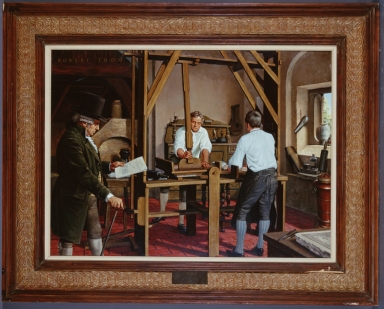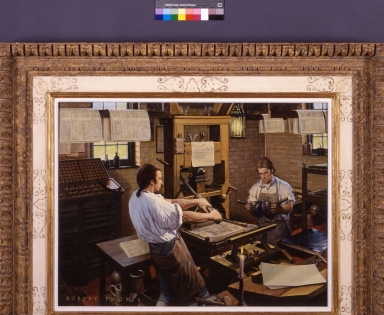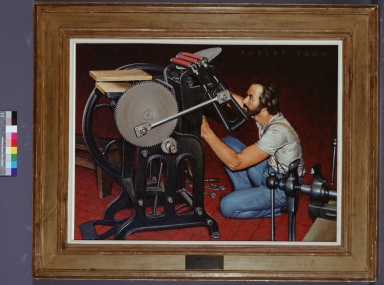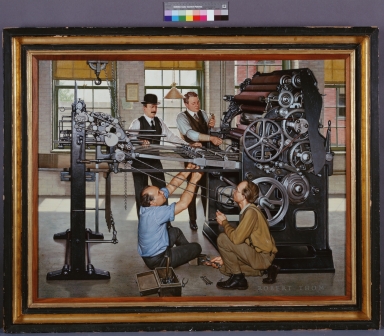|
REFINE
Browse All : oil paintings and Printing presses - History by Kimberly-Clark Corporation
1-6 of 6
Title
Alois Senefelder and Lithography
Creator
Thom, Robert A., 1915-1979
Summary
Near the close of the century, a young Bavarian playwright named Alois Senefelder sought a method of printing his own plays. His first efforts were engraved and etched on copper and printed on a makeshift intaglio press. The high cost of copper led Senefelder to experimentation with limestone slate. In 1796, a happy accident occurred. Having no paper immediately at hand, Senefelder wrote out an urgently needed laundry list on a polished piece of stone with a greasy ink mixture. Curiosity led him to the discovery that it was not necessary for the printing surface to be raised in the usual manner. The greasy image surrounded by the water-attracting stone surface accepted ink, while the dampened part of the stone rejected it. Printing from a plane or level surface, of lithography as we know it was born. Pursuing his discovery, Senefelder succeeded in adapting his process to metal plates by 1803.
Title
Alois Senefelder and Lithography
Creator
Thom, Robert A., 1915-1979
Summary
Near the close of the century, a young Bavarian playwright named Alois Senefelder sought a method of printing his own plays. His first efforts were engraved and etched on copper and printed on a makeshift intaglio press. The high cost of copper led Senefelder to experimentation with limestone slate. In 1796, a happy accident occurred. Having no paper immediately at hand, Senefelder wrote out an urgently needed laundry list on a polished piece of stone with a greasy ink mixture. Curiosity led him to the discovery that it was not necessary for the printing surface to be raised in the usual manner. The greasy image surrounded by the water-attracting stone surface accepted ink, while the dampened part of the stone rejected it. Printing from a plane or level surface, of lithography as we know it was born. Pursuing his discovery, Senefelder succeeded in adapting his process to metal plates by 1803.
Title
Benjamin Franklin
Creator
Thom, Robert A., 1915-1979
Summary
One of America's greatest patriots, a framer of the Declaration of Independence, a statesman whose charm and tact played a tremendous role in securing for the Colonists the aid of France during the Revolutionary War, Benjamin Franklin was also a skilled scientist, author, editor, publisher and printer. Beloved among his many writings was the series of Poor Richard's Almanacs, published annually between 1732 and 1758 in issues as large as 10,000 on a hand press. The volumes quickly gained a wide and appreciative audience, and their homespun, practical wisdom exerted a pervasive influence upon the American character.
Title
Friederich Koenig and the Cylindrical Press
Creator
Parrish, Douglas M., 1922-2001
Summary
After centuries of use, history's oldest printing machine, the hand press, was finally superseded when Frederich Koeing sold his first power-driven press to The London Times in 1814. Koeing's invention instantly lowered printing and composing costs by 25 per cent and made possible the production of cheaper and larger publications of every kind. His contributions to the graphic arts were presses with increased multiplying capacities which soon replaced manpower with machine power. From his inventions came today's entire line of modern, high speed printing machines.
Title
George P. Gordon and the Platen Press
Creator
Thom, Robert A., 1915-1979
Summary
The first of an illustrious line of Gordon job presses, standard equipment for commercial printing for years, was invented and put on the American market by George Phineas Gordon in 1851. The press was a small jobber operated by a treadle, and it had no throw-off. Gordon presses have appeared in various forms since the inventor's early model and are still operating and turning out job printing as efficiently as they did in the 19th century.
Title
Ira Rubel and the Offset Press
Creator
Thom, Robert A., 1915-1979
Summary
A milestone in graphic arts history occurred in the early 1900s when a New Jersey printer named Ira Rubel accidentally used a rubber cloth as a cylinder on a lithographic press. Due to Rubel’s negligence in feeding paper, an impression was made on the cloth. When the next sheet went through the press, an extremely vivid impression was obtained on its reverse side. On the basis of this principle, Rubel invented his offset press in 1905.
1-6 of 6
|





